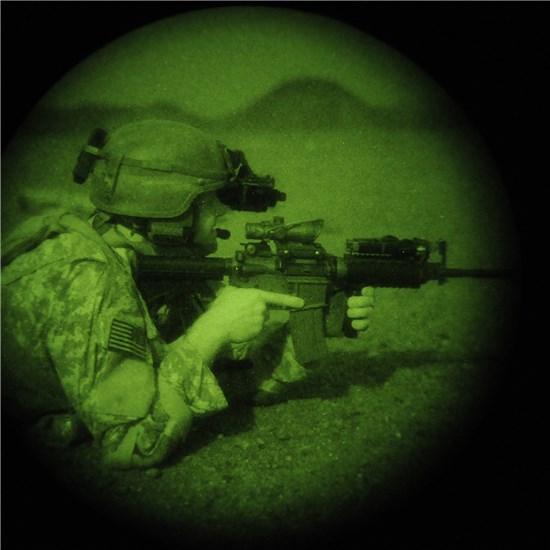 |
| Texas National Guardsmen conduct night operations training. The Soldiers are part of the Site Security Team, Task Force Raptor, 3rd Squadron, 124th Cavalry Regiment deployed in support of Combined Joint Task Force-Horn of Africa, whose mission is to promote regional stability, dissuade conflict, and protect U.S. and coalition interests |
Story by Staff Sgt. Phil Fountain and Laura Lopez
CAMP MABRY, Texas – During the past decade, the Texas Army National Guard has evolved from a Cold War-era strategic reserve force to a high-tempo operational reserve force, and deployed more than 50,000 soldiers to locations abroad and here at home. These missions have included combat operations in the Middle East as well as hurricane and wildfire support missions here in the Lone Star State.
Maj. Gen. John F. Nichols, the Adjutant General of Texas, and Maj. Gen. Joyce L. Stevens, the Assistant Adjutant General for Army, have made fiscal responsibility and accountability a focal point for the Texas Army National Guard.
“Fiscal responsibility is a top priority,” Nichols said, the state’s senior military official appointed by the governor. “Our goal is to always be mission-ready, and that includes accounting for our property.”
Nichols said that the increased number of financial liability investigations in recent years reflects this leadership emphasis.
“The Texas Army National Guard is the largest Army National Guard force in the nation,” Stevens said. Ninety percent of our force is part-time, with only a little over ten percent working full-time to ensure deployment readiness.
“We have more than 19,500 traditional Guard Soldiers that drill one weekend a month,” she said. “Since 9/11, Texas has deployed Army Guard soldiers throughout the United States and to 40 countries around the world in response to federal and state requirements,” Stevens said.
Because of its size, the Texas Army National Guard is responsible for about $2.53 billion in property, which includes installation property, such as office furniture and buildings, and equipment issued to individual Soldiers, including tents, canteens and protective armor, said Lt. Col. Stanley E. Golaboff, Director of Logistics for the Texas Army National Guard.
This can be a daunting task in a state that spans 268,000 square miles and includes 96 armories and 17 joint reserve centers.
“We need to know where our property and equipment are so it’s ready when the time comes to respond to a call from our civilian leadership,” Nichols said.
Since 2008, the Texas Army National Guard has documented about $3.5 million in property losses.
“Of the $3.5 million, nearly $2 million occurred during the 36th Combat Aviation Brigade’s recent deployment to Iraq,” Golaboff said. “This includes damaged equipment that has to be documented as a loss, as well as gear that was reabsorbed by the active duty Army logistics system.”
For the last five years, the Texas Army National Guard has had to investigate annually the loss of less than 1/10th of 1 percent of the property entrusted to the organization by the U.S. Army to prepare units for deployment, Golaboff said.
While property can be lost as a result of damage or destruction during a dangerous mission, soldiers can be held liable if they lose or abuse their equipment.
“Our increased investigations have led to the recovery of $500,000 from soldiers,” Golaboff said. “We are determined to ensure that any loss of equipment is properly documented – immediately – and if a service member is found to be the cause, then he or she is held financially liable.”
The state’s military leaders want to ensure the military organization is responsive to Texas taxpayers.
“The Texas Army National Guard remains committed to transparency and accountability to the citizens of Texas while providing the governor and president with ready-trained forces,” Stevens said.